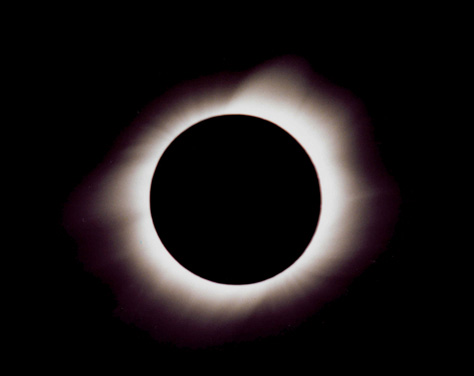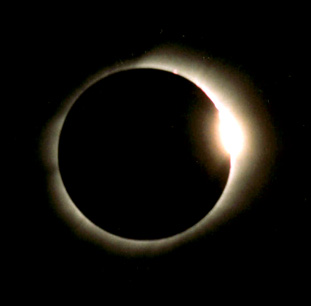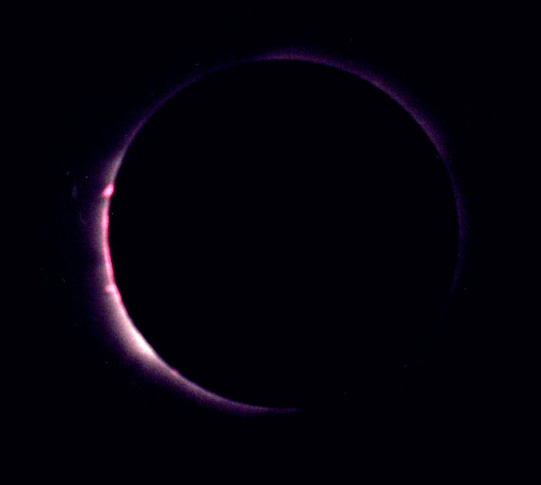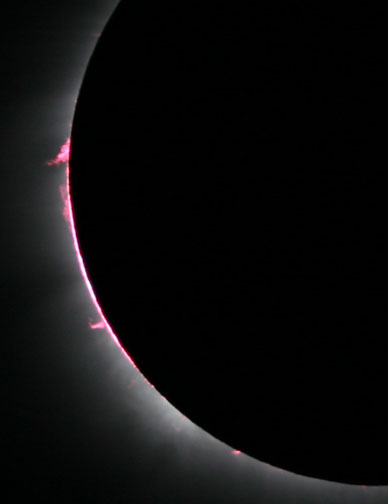and 2x extender using Kodak Max film


at third contact

near the 9 o’clock position

(Photo by Robert Gillette)
Every night leading up to the eclipse was clear, except for the morning of the eclipse — an overcast sky with no stars visible. Not a good omen. However, by the time of totality (about 11 AM) most of the haze had burned off, thus providing a spectacular view of the sun's corona, once moon had done its heroic job of blocking the entire surface of the sun. This began at what is known as "second contact," which was immediately preceded by the appearance the "diamond ring," an effect where the last bit of the sun's surface shone through a valley on the moon's limb. At second contact the diamond ring dissolved into prominences at the 9 or 10 o'clock position, which were then covered up as the moon continued to pass over the sun's surface. The corona was an unusually elongated affair this time due to sunspots being at a minimum (which mutes the corona at the poles). Because of the haze, only Venus was readily visible, among the stars and planets in the dark sky. There were no shadow bands, no approaching shadow, no clear 360° twilight on the horizon. I dragged along a thermometer, which recorded an 86-degree peak an hour before totality and dropped to 76 degrees during totality. The sun's corona — never seen outside of a total eclipse — is the most spectacular phenomenon of an eclipse. Although it is imperfectly captured on film and video, such media does give a fair representation of what is seen. However, what cannot be experienced secondhand is the unworldly eeriness of totality and its approach. The eclipse — totality and the lead up to it — was far more than viewing of the corona. It was also a feeling that impacted many senses as the sky darkened, the air became cooler, the nervous anticipation of observers, and the sudden appearance of the diamond ring as the sun's surface blinked out of existence and the corona breathtakingly appeared, as if someone had just flipped a switch. Though many feel the most striking aspect of totality is the sun's corona, others feel the rushing shadow chasing across the Earth's surface at more than 1000 miles/hour and engulfing the observer is akin to a religious experience — not something I can vouch for. Still others are mesmerized by the prominences, diamond ring, and Baily's beads. While a few feel the sensory whole of totality is the ultimate experience. You begin to notice something is happening roughly half an hour before totality. The sky has become darker, in a twilight kind of way. A quarter of an hour or so before totality, the drop in temperature has made its presence obvious, and a glance from the corner of my eyes — even without the protective eclipse glasses — it is clear that the sun is but a sliver of its former self. The observers are in anxious anticipation and are even becoming a bit jittery with excitement. A lot begins to happen in the last ten minutes before totality. Much to observe, to take in, much too much in fact, because various phenomena happen very quickly. Many of us are prepared to look for all these things — pinhole-like projections of the crescent sun through the leaves on the onto the ground, the illusive shadow bands (which did not show up at this eclipse), birds and other animals heading back to nest (didn't see many at our site), the sky blackening, stars appearing. At third contact, prominences appeared, totality ended, and the corona was switched off as a diamond ring once again reappeared, planets and stars disappeared, the sky brightened, observers reacted and exhaled in a celebratory atmosphere that included swapping stories, "did you see [that]!?", comparing notes, recounting phenomena. Virtually ignored now is the sun as more and more of its surface is reclaimed from the moon's cover. The eclipse goes from third to fourth contact, when the moon and sun become completely uncoupled — a process that took about an hour and 20 minutes. Completely gone was the anticipation that preceded totality. A few people continued to photograph and observed the final phases of the eclipse but most packed up their equipment, photographed each other, reviewed video and digital images of the four minutes and five seconds of totality (observers in southern Libya had two more seconds), and talking about the next eclipse. "Seen one and you've seen them all" was not the mantra of this group. Not only is each total eclipse different, the experience doesn't last long enough or happen often enough for one to become sated. This is arguably the most spectacular and one of the rarest phenomenon in nature. Ed |
Live
Webcast of the Eclipse
The
SF Exploratorium and NASA produced a live Webcast of the eclipse
from Turkey
(to view, click on link above)
A 1994 annular eclipse photo by Ruth (go to page 5 of this Acrobat PDF)
An account by Ed of how he became involved "chasing" solar eclipses